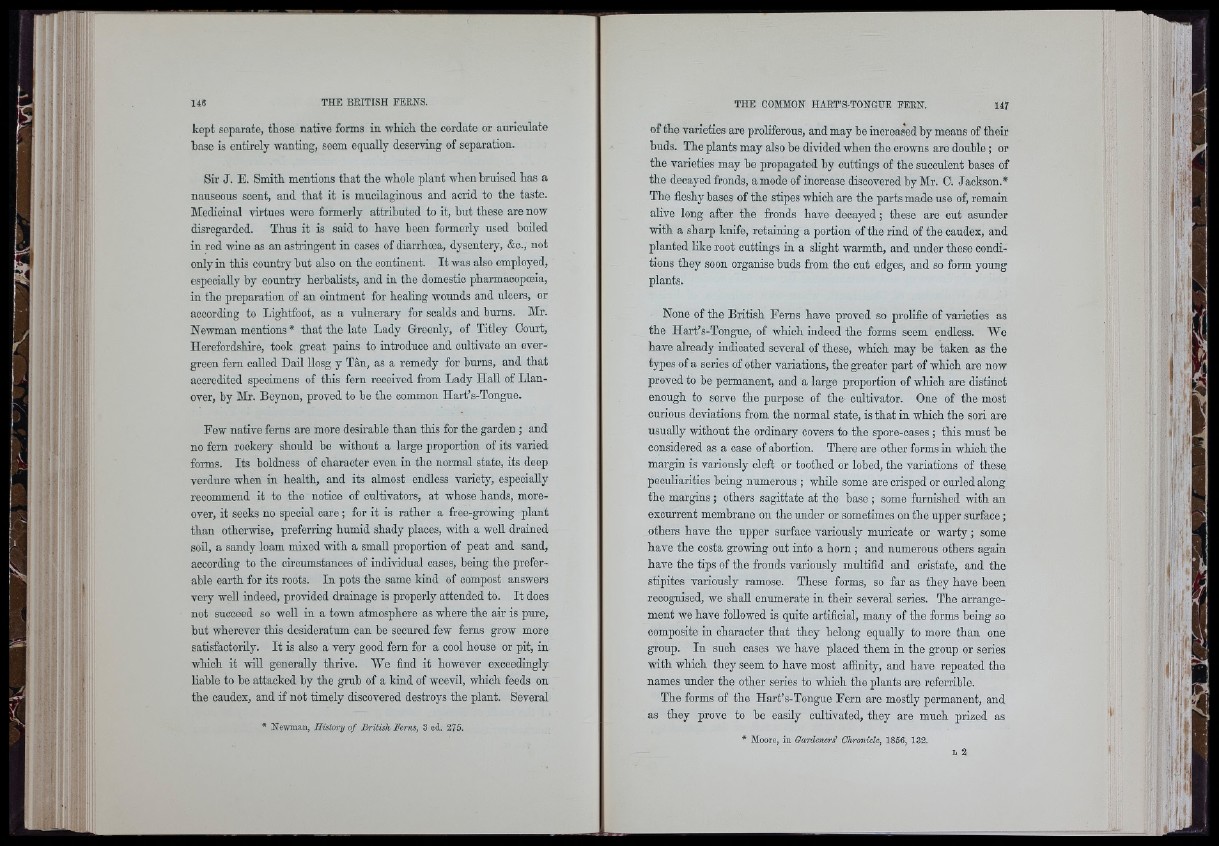
I
kept separate, those native forms in which the cordate or auriculate
hase is entirely wanting, seem equally deserving of separation.
Sir J. E. Smith mentions that the whole plant when hruised has a
nauseous scent, and that it is mucilaginous and acrid to the taste.
Medicinal virtues wore formerly attributed to it, hut these are now
disregarded. Thus it is said to have been formerly used boiled
in red wine as an astringent in cases of diarrhoea, dysentery, &o., not
only in this country but also on tho continent. It was also employed,
especially by country herbalists, and in the domestic pharmaoopoeia,
in the preparation of an ointment for healing wounds and ulcers, or
according to Lightfoot, as a vulnorary for scalds and burns. Mr.
Newman mentions * that the late Lady Greenly, of Titley Court,
Herefordshire, took great pains to introduce and cultivate an evergreen
fern called Eail Uosg y Tân, as a remedy for burns, and that
accredited specimens of this fern received from Lady HaU of Llan-
over, by Mr. Beynon, proved to be the common Hart’s-Tongue.
Few native ferns are more desirable than this for the garden ; and
no fern rookery should he without a large proportion of its varied
forms. Its boldness of character even in the normal state, its deep
verdure when in health, and its almost endless variety, especially
recommend it to the notice of cultivators, at whose hands, moreover,
it seeks no special care ; for it is rather a free-growing plant
than otherwise, preferring humid shady places, with a weU drained
soü, a sandy loam mixed with a smaU proportion of peat and sand,
according to the circumstances of individual oases, being the preferable
earth for its roots. In pots the same kind of compost answers
very well indeed, provided drainage is properly attended to. It does
not succeed so weU in a town atmosphere as where the air is pure,
hut wherever this desideratum can he secured few ferns grow more
satisfaotorüy. It is also a very good fern for a cool house or pit, in
which it wiU generally thrive. W e find it however exceedingly
liable to be attacked by the grub of a kind of weevil, which feeds on
the caudex, and if not timely discovered destroys the plant. Several
* Newman, History o f British Ferns, 3 ed. 275.
of the varieties are proKferous, and may be increased by means of their
buds. The plants may also be divided when the crowns are double; or
the varieties may be propagated by cuttings of the succulent bases of
the decayed fronds, a mode of increase discovered by Mr. 0. Jackson.*
The fleshy bases of the stipes which are the parts made use of, remain
alive long after the fronds have decayed; these are cut asunder
with a sharp knife, retaining a portion of the rind of the caudex, and
planted like root cuttings in a slight warmth, and under these conditions
they soon organise buds from the out edges, and so form yoimg
plants.
None of the British Ferns have proved so prolific of varieties as
the Hart’s-Tongue, of which indeed the forms seem endless. We
have already indicated several of these, which may be taken as the
types of a series of other variations, the greater part of which are now
proved to be permanent, and a large proportion of which are distinct
enough to serve the purpose of the cultivator. One of the most
curious deviations from the normal state, is that in which the sori are
usuaUy without the ordinary covers to the spore-cases ; this must be
considered as a case of abortion. There are other forms in which the
margin is variously cloft or toothed or lobed, the variations of these
peculiarities being numerous ; while some are crisped or curled along
the margins ; others sagittate at the base ; some furnished with an
exourrent membrane on the under or sometimes on the upper surface;
others have the upper surface variously muricate or warty; some
have the costa growing out into a horn ; and numerous others again
have the tips of the fronds variously multifid and cristate, and the
stipites variously ramose. These forms, so far as they have been
recognised, we shaU enumerate in their several series. The arrangement
we have foUowed is quite artificial, many of the forms being so
composite in character that they belong equaUy to more than one
group. In such cases we have placed them in the group or series
with which they seem to have most affinity, and have repeated the
names under the other series to which the plants are referrible.
The forms of the Hart’s-Tongue Fern are mostly permanent, and
as they prove to be easily cultivated, they are much prized as
* Moore, in Gardeners' Chronicle, 1856, 132.
'(I I
'it
' I
i"! /• I
îi:"'
llii
PI
, I
If